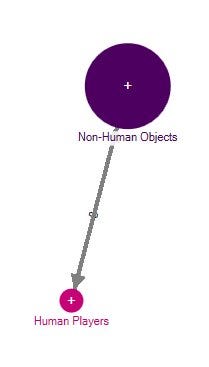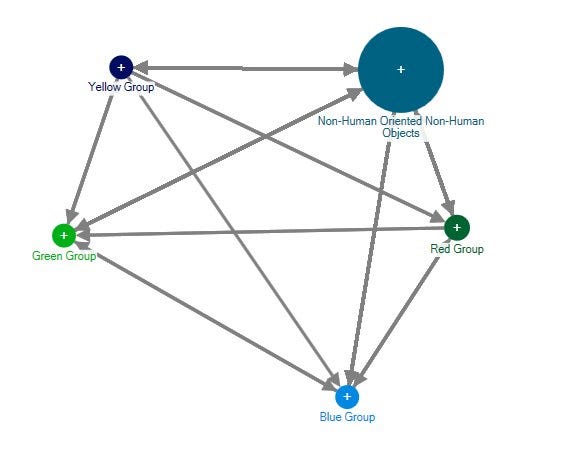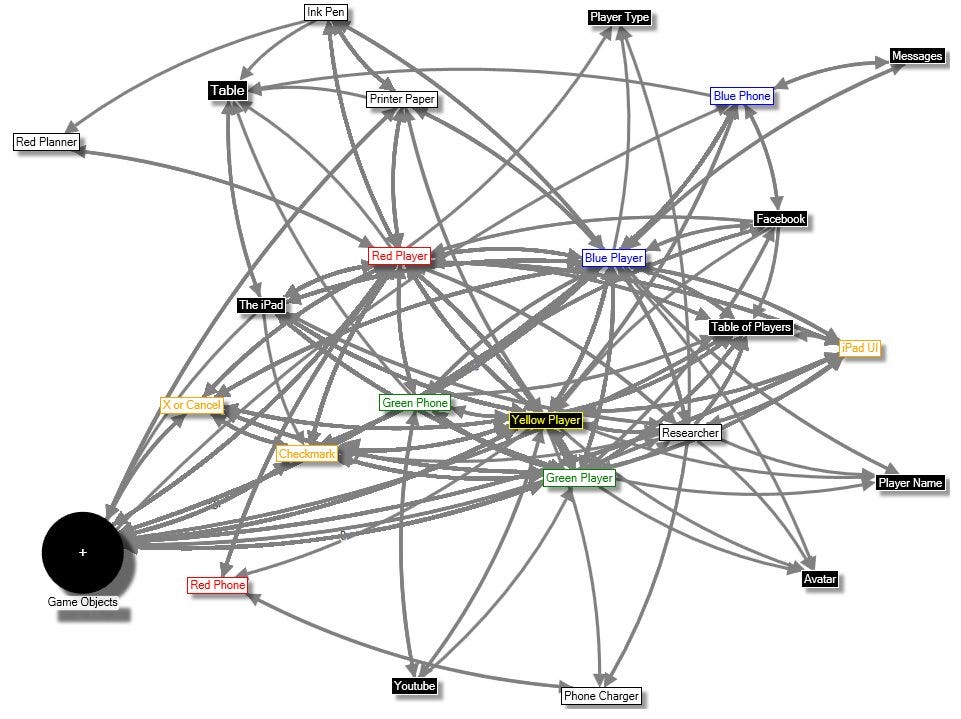On the Impact of Nonhumans in Social Network Analysis
Published:
I got some reviews back the other day on my first attempt to produce something from my dissertation research. Of the reviews, one aspect that stood out was that there was a need for “more detail.” Simple associations like those found in Social Network Analysis just aren’t enough for something substantial. And, for the most part, I agree.
On the Impact of Nonhumans in Social Network Analysis
There is a certain aspect of what i’m trying to pursue with this work that could simply be called, “The impact of anthropomorphism.” From a design perspective, the idea of certain aspects of a computational system are being reacted to and interacted with as “human” is of particular interest. After all, if you can reliably predict what aspects of any software are going to be anthropomorphized, why wouldn’t you want to enhance that? It’s easier to learn from a friend than it is from an uncaring machine.
While that could be called the eventual goal of this method, as it stands, i’m at the starting line trying to figure out what sport i’m playing.
Before any development can happen, it is necessary to define what a map of associations is, how that map of associations is formed, and what objects are included. Even within those questions is a more sinister one: *how do you determine groups within an assemblage or monadology? What is the selection criteria? *Do you simply allow the objects to mark themselves? Or, within design, do you specify by the designer’s idea about what groups can and should exist.
The most obvious way to separate objects into groups is to separate all of the humans and all of the non-humans. Within SNA, this provides something that…is perhaps worse than only including humans and humans only.
 Social Network with only Non-Humans and Humans as Vertices.
Social Network with only Non-Humans and Humans as Vertices.
But what is this? One black box interacting with another black box. It’s directional because there is an association that occurs between these two sets of actors.
It isn’t enough to simply separate the non-human objects from the human objects. At its core, any activity is going to consist of humans and nonhumans forming bonds to achieve goals. Without these bonds, without these associations, there is no agency.
So the next step might be something like separating those objects that humans must use to achieve goals into groups. Since I am using *Catan *as an example space for this method, the group of objects that make sense are:
 A standard map. The red, white, orange, and blue pieces represent the players and are most likely to be those things that require grouping.
A standard map. The red, white, orange, and blue pieces represent the players and are most likely to be those things that require grouping.
Player — as in, the player themselves.
Cities — the upgraded settlement pieces.
Settlements — the pieces that represent a settlement of that player’s people.
Road Pieces — the little bits of wood that allow the players to traverse the map.
Player Resources — Bricks, Ore, Sheep, Wood, and Grain owned by the player.
Their Phone — because no one is without their phone and I didn’t police it.
But what does this do to the map? If these objects are grouped, then what is gained in terms of knowledge? How does this impact the possible insight into what users are doing with a particular group of non-human objects?
 I suppose it looks a little demonic.
I suppose it looks a little demonic.
In a sense, this is still the same issue. By grouping the objects humans require to achieve their agency, we must effectively black box all of those objects humans must recruit in order to even make their own resources effective.
This is where grouping becomes an issue. While SNA can map direct associations between things, it does little to connect the consequences of chains of associations.
For example, in order for me to build a road as a player in Catan, I need to have 2 resources — a piece of wood and some brick. However, in order for me to achieve that goal, the dice, the numbers on the terrain, and the terrain itself must be recruited in order to achieve that goal. As such, to simply include the result of a complex chain of associations is simply more black boxing.
However, we do gain some insight. While the players are connected to their non-human objects, there is still a lot more going on within this assemblage at the non-human level than the human level. In the above picture, the non-human objects are drawn according to their number. The sheer number of objects is so massive that we have no choice but to break them down. This is where SNA that includes non-human objects becomes something of a tremendously time-intensive task.
Going back to that review, the thing that is of interest is that the “action” an object takes that results in the “re-action” from a human is of particular interest to them. The review went on at length from this premise. It is indeed a powerful statement to be able to mark the time, the context, and the consequences of anthropomorphizing. Within Catan, this happens quite often — the dice hate me, stupid sheep, and more. However, the reason this is an eventual goal is that the act of mapping out what I currently have has been months and months of work.
I know i’m not alone in trying to engage this particular method. It has been attempted here and there. My favorite attempt thus far is from Dr. Jamie Banks (@amperjay on twitter). Banks attempted to do something similar specifically in the realm of Communication.
In her piece, she presented:
Object-relation mapping: A method for analysing phenomenal assemblages of play Theories of play assemblages and technological agency have met popular acceptance in game studies. However, current approaches to empirically examining these notions are limited to resource-intensive ethnographies not suitable for many types of enquiries, particularly those focusing on micro-level analyses and the lived experiences of play. This article proposes an analytical method called ‘object-relation mapping’ (ORM). ORM incorporates techniques from Actor–Network Theory, social network analysis, phenomenology and Grounded Theory to examine phenomenal assemblages of play at micro-, meso- and macro-levels. In particular, ORM provides a systematic framework for collecting, deconstructing, restructuring and coding data gleaned from players’ subjective experience of play. This article outlines ORM’s theoretical underpinnings, techniques, benefits, challenges and extensions.
Within this, Banks attempted to present a 1-level stand point (micro-, meso-, and macro-) by processing interview data computationally. She intends to offer a means through which to gain insight into a human-centric world made up of objects humans relate to. By understanding what terms are associated with what objects, there’s a level of insight that hasn’t been possible in the past. While I would offer that ANT itself is not a set of ideas that would afford humans such a hierarchically superior place within any assemblage, the benefit from this method is sound. It is a also fantastic paper and raises a lot of interesting ideas about what Graph Theory can do within a corpus of text — regardless of the text’s origin (subjectivity/objectivity/generalizability as matters of concern). While this is not necessarily SNA, it still uses the same processes.
She concludes with what i’m feeling right now.
Because of these difficulties and the nature of the object-relation cataloguing and the coding process, the ORM method can be tedious and time-consuming. Each phase of the project may take many months, multiple iterations and meticulous attention to detail. Further, because situations are emergent and ephemeral, networks are unstable (see Law 2009; Rabinow 2003; Taylor 2009) and the researcher must either settle for a ‘snapshot’ of a situation at a particular point in time) or continue to trace object-relations and evolve the situation network landscape as the situation itself evolves.
There’s a certain level of tedium that is necessary to consider. The entire reason that Gabriel Tarde’s work was not followed through on was that it simply wasn’t mathematically possible. At the moment, while graph theory is still somewhat “new” it is not outside the realm of possibility to create a model that can grow or shrink dynamically over an undefined concept of time. Nor is it outside of the realm of time and effort with the tools that exist in the present.
So in the end, what are the groups in question? To be honest, as i’ve considered this, I have not come up with a good schema. I’ve added variables to the various edges about who is associating. I covered this in the last post I put up. I’ve also included what aspect of the assemblage that particular edge represents. Inside the magic circle are supposed to be those objects that maintain the space inside. However, bridging devices like phones and tablets allow for us to maintain multiple circles all at once. So, while these are variables and not groups, some grouping manages to occur by simple variable label.
One thing that I will note is that grouping does allow you to define the black box. As a designer, there are some things you probably should box up. The core functionality and security of a system are important enough to box up to the point where they are not accessible by the user. So too are the various parameters of a game. However, something magical occurs when you group all of the objects of a game — that thing that is supposed to be the system maintained inside the magic circle look somewhat different.
 Outside of the magic circle is an entire circle in and of itself
Outside of the magic circle is an entire circle in and of itself
The interesting thing about this visualization is that the game objects are intended to be the parameters of the game. They are those things that make up what the magic circle has bounded.
We often only afford this type of language, these types of analyses to play and games. However, they are not limited to play insomuch as play is the manner through which society itself formed. As rule keepers of countless magic circles that must be maintained daily, weekly, hourly, or even by the minute during a lunch break, I want to bring a way to visualize these complexities and also to allow them to be understood, to be used in design itself.
So sure, I haven’t provided a level of detail that is, of itself, useful to everyone but starting somewhere seems better than doing nothing.
